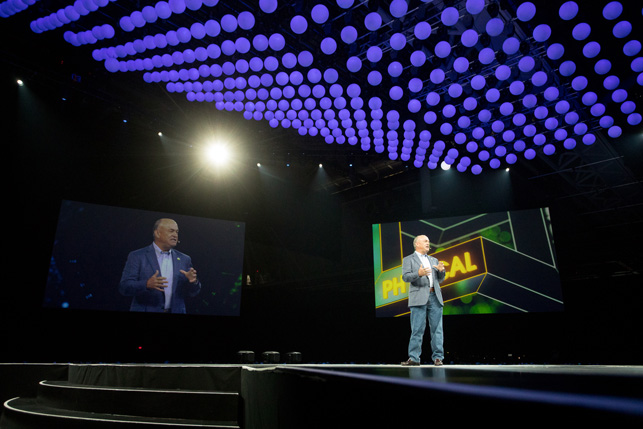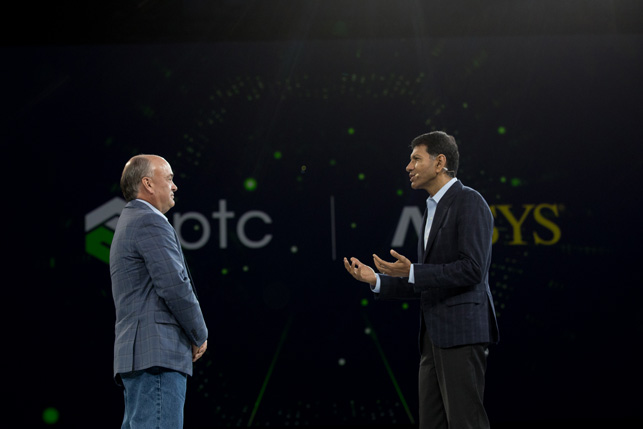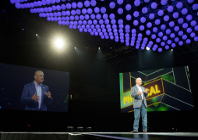
PTC’s Chairman and CEO Jim Heppelmann
The company formerly known as Parametric Technology Corporation, but which today goes by the rather simpler name of PTC, is on a transformation journey so profound and fundamental that those initials should really stand for ‘Prepare To Change’. That was the message from PTC CEO Jim Heppelmann to over 6,000 attendees at the company’s LiveWorx event, held in Boston this June. The changes sweeping the company’s customer base are no less profound, he added, as machines become more connected and smart factories become the new normal.
“Today it’s no longer sufficient for companies, or us as employers, to think about some future state, some Point B, as their destination, and then move methodically towards that place,” he said.
“That type of mindset allows everybody to close their mind, to build up inertia around a point-in-time understanding of the world around us. Inertia, ultimately, is your main competitor, because it’s the enemy of change. When we stand with a fixed view of the future, by the time we get there, we find that the world around us has changed in ways we never anticipated.”
With his keynote off to a suitably rousing start, Heppelmann went on to describe some of the changes that PTC is making in its bid to better serve companies operating in a world increasingly characterised by technologies such as the Internet of Things (IoT), virtual and augmented reality (VR/AR), robotics and blockchain.
PTC – From place to pace
First off, the company is on the move, shifting its global headquarters from the somewhat sleepy Boston suburb of Needham to a glittering tower in the city’s Seaport district, an area making a name for itself as Boston’s ‘innovation district’.
PTC will take up 250,000 square feet as the anchor tenant at 121 Seaport Boulevard. Around 1,000 PTC employees will work there in an open floorplan environment, apparently designed to drive collaboration and innovation.
“No-one will have a dedicated office – not even me,” Heppelmann promised. The new premises will also be home to a new PTC customer experience centre, occupying the top floor of the building, where customers can get up close and personal with new technologies.
Real estate deals aside, another big change is PTC’s recently inked partnership with factory automation specialist Rockwell Automation. Announced in the week prior to kick-off at LiveWorx, this sees Rockwell invest a cool $1 billion in PTC. Rockwell chairman and CEO Blake Moret, who joined Heppelmann on stage at Liveworx, will join PTC’s board of directors.
The thinking behind this tie-up is that a factory can only ever be as smart as the software that runs it, so the two companies are teaming up to push a joint vision of the smart factory to companies interested in injecting their industrial environments with hefty dose of digital.
In particular, they will package up a number of their software products as a smart factory ‘bundle’ for customers. These include PTC’s industrial IoT (IIoT) products – principally, its Vuforia augmented reality (AR) tech, its Kepware integration software and its ThingWorx IoT platform – alongside Rockwell’s FactoryTalk manufacturing execution system (MES) suite and related analytics products.
The key thing here is reach. According to Heppelmann, most of PTC’s smart factory sales have up until now been handled by the company’s internal direct sales group, which numbers around 330 individual sales teams. Only 25 of these teams, however, are specifically focused on factories. By contrast, Rockwell has over 1,000 sales teams working specifically with factories.
In other words, it’s an opportunity to get PTC selling its IIoT-focused products – all acquired technologies – into a far broader customer base. Between them, ThingWorx, Kepware and Vuforia arrived at PTC during the past five years at a combined cost to the company of around $300 million. But they’re driving growth and Heppelmann wants to see that growth continue.
CAD and PLM
While the keynote firmly travelled an ‘Industry 4.0’ path, that is not to say that PTC’s mainstay CAD and PLM products didn’t get a look-in. In fact, Heppelmann was joined on stage pretty early in his presentation by Ansys CEO Ajei Gopal to announce a tie-up between the two companies. This will see simulation capabilities from Ansys embedded into Creo, with the result that users can visually assess the impact of design changes as they are made.
The first fruits of this partnership will support real-time structural, thermal and modal simulations in Creo, but increasingly advanced simulations are promised over time.
“By embedding Ansys Discovery Live into Creo, we will expand our audience to include design engineers, who will be able to design at the speed of thought,” said Gopal.
“The power of simulation will now be readily provided to engineers as they make thousands of decisions and model explorations, providing them with unprecedented insight into design choices.”
Things were somewhat quieter on the PLM front, but PTC did use the event to showcase two new customer wins in this part of its business.
Ceiling fan manufacturer Hunter Fan Company, based in Memphis, is expanding its PTC product portfolio to include PTC’s FlexPLM retail software, in addition to its existing use of Creo and the Windchill PLM software.
This will enable the company to consolidate systems and manual activity that persist beyond the engineering bill of materials (BOM) in order to increase design accuracy and speed to market.
And Japanese industrial equipment manufacturer Sinfonia Technology has selected Windchill to improve operational efficiency, time to market, quality assurance and team collaboration at its clean transport equipment factory in Toyohashi.

Jim Heppelmann with his Ansys counterpart Ajei Gopal, launch Creo with added realtime simulation, courtesy of Ansys Discovery Live
IIoT: Star of the show
The stars of the LiveWorx show, however, were undoubtedly the company’s IIoT products. During his keynote, Heppelmann was joined on stage by employees from defence, security and aerospace giant, BAe Systems, which has created a visual training aid using Vuforia and Microsoft’s HoloLens head-mounted display (HMD), to guide workers in manufacturing plants through the process of building a batter for a greener, electric-powered bus.
In addition, attendees saw a lab technician from Sysmex America, a manufacturer of clinical laboratory equipment, being guided through the process of setting up machines for daily blood analysis via an AR headset. This example uses technology from Waypoint, a start-up recently acquired by PTC that will be integrated into the company’s Vuforia product line.
The reason that IIoT was given such prominence was perfectly clear. These are the real focus for future growth at PTC, as Heppelmann made clear in a later press conference. The company’s IIoT software business is growing at around 40% annually, he said.
In revenue contribution terms, that makes it already as big as the PLM business and it will overtake PLM next year, he predicted. While still not as big as the company’s CAD software business, IIoT looks set overtake CAD in 2020.
Speaking as much of his own business as the companies that PTC serves, Heppelmann told attendees: “We need a mindset where clock speeds are short, innovation is continuous and where a willingness to react quickly and change frequently is viewed as a core competency.”
PTC is clearly working hard to set out its stall as a software company rich in exactly that kind of competence.

PTC LiveWorx 2018 report
Default






